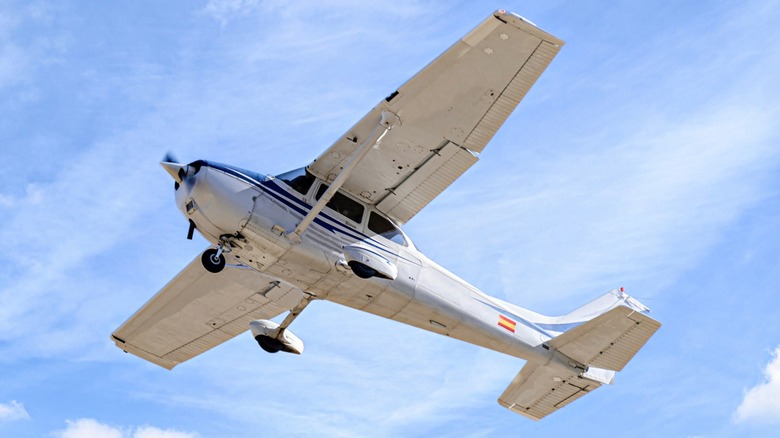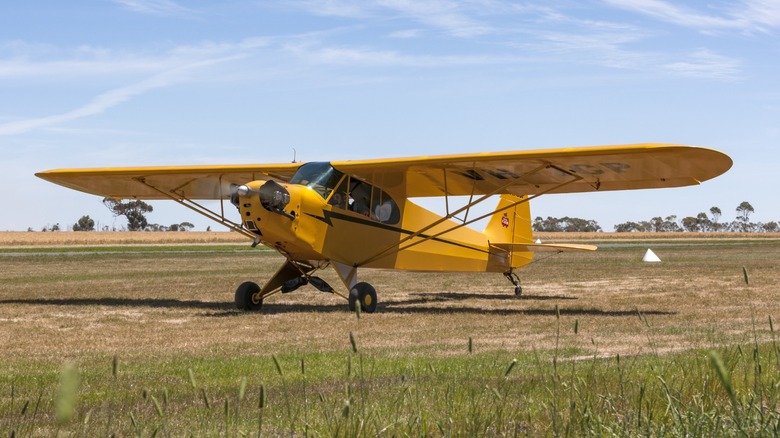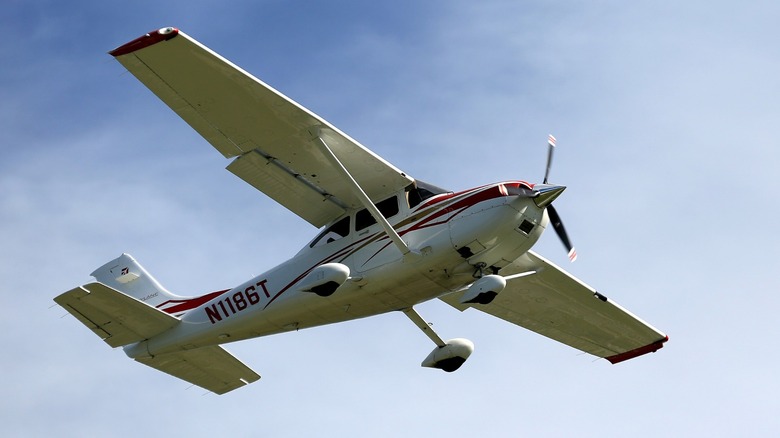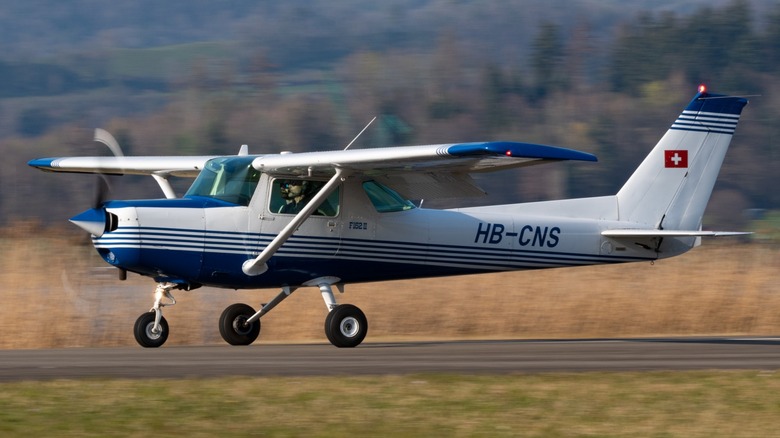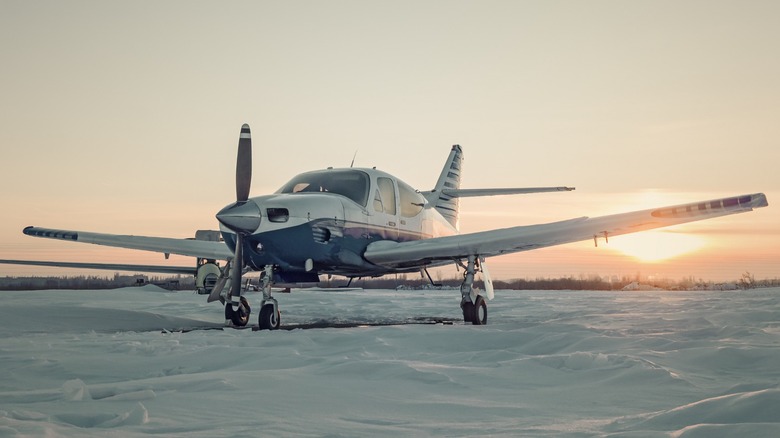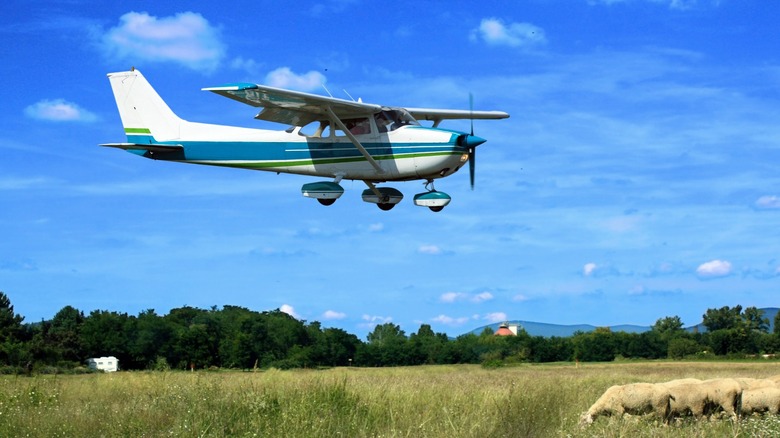5 Of The Most Popular Single-Engine Planes
When you read about "most popular planes," you might imagine either an iconic fighter jet like the F-16 or MIG-15 or a workhorse airliner like the ubiquitous Boeing 757. In fact, many of the world's most-produced aircraft fall into neither category. Not only are they not jet airliners or fighter jets; they aren't even jets. The most common design in aviation is the single-propeller piston-engine aircraft.
Some warplanes fit that description and a few of them had wide production – some of the top fighter aircraft of World War II, for example – but we're putting military aircraft aside for today. Instead, we're looking at the aviation world's unsung but practically universal mascot: the small general aviation aircraft. We'll also dive into what made those planes popular and how long they've stayed that way. So, let's start counting and see which airplanes are the most popular birds in the sky.
Piper J-3 Cub
The Piper J-3 Cub is a steel and fabric tail-dragger that first flew in 1938. Because of its cheap and reliable construction, it was popular as a training plane for student pilots. Made in America and taking to the air just one year before Germany invaded Poland, it was perfectly positioned for training the thousands of pilots needed for the coming war.
At the peak of wartime production, Piper was making one J-3 Cub every 20 minutes to fill the training needs of the U.S. Army Air Force. Because of this, nearly 80% of US military pilots started their initial training on the Cub during and after the war. If you ask a pilot in the 1980s where they began training, they likely will tell you it all started with a Cub.
Production of the J-3 Cub continued until 1947, when the PA-18 Super Cub superseded it. By then, the company had made over 19,000 of the J-3. However, despite being out of production for over 77 years, more than 5,000 of the original J-3 airframes are still registered with the FAA — a testament to the longevity and reliability of this plane. It remains a popular plane among bush pilots, who prize the Cub's robustness and the tail-dragger design that helps with its takeoff and landing performance.
Cessna 182 Skylane
While the Piper J-3 Cub was famous as a training plane for new pilots, the Cessna 182 Skylane, with its four-seat capacity, is more suitable for friends and families. The 182 started as the tail-dragger Cessna 180 Skywagon, but since tricycle landing gears are much easier for pilots in normal flight conditions, Cessna developed it into the Skylane.
The Skywagon started production in 1952, while the 182 Skylane was made in 1956. But what made this an astounding aircraft is that it's still in production today. According to some figures, the Cessna 182 has sold over 20,000 units since its introduction in 1956, which is no surprise given the longevity of the model.
You can buy a factory-fresh Cessna Skylane today, giving you a 915nm range and a 145-knot maximum cruise speed. Its 1,110-pound useful load will let you comfortably fly four adults cross-country, making the 182 an excellent plane for taking friends and family to destinations.
Cessna 150/152
While the Piper J-3 Cub was the trainer aircraft of choice from the 1940s, the Cessna 150 and its 152 modification became the popular flight school aircraft when it was produced from 1958 until 1985. The last variant of this two-seat trainer was powered by a Lycoming O-235 capable of putting out 110 hp.
Despite being out of production for over 39 years in 2024, the Cessna 150/152 is still popular among flight schools, especially those operating in less-developed countries. In fact, this writer started his flying career on a 1977 Cessna 152 in 2019.
Because of the ubiquity of this model – with over 31,000 units sold — many find the Cessna 150/152 economical to operate. It has a robust engine, many mechanics are familiar with it, and you can readily buy parts that need replacement. Furthermore, there are many different variants to the 150/152, including the Aerobat, which has strengthened wings and fuselage for aerobatic maneuvers.
Piper PA-28 Cherokee
Another popular light utility aircraft is the PA-28 Cherokee, which started production in 1960. This is another Piper product that focuses on training and personal use and is available in either two-seat or four-seat variants. Unlike the Cessna offerings, the Piper Cherokee is a low-wing aircraft, allowing the pilot to get better views of the sky above them.
Through the years, Piper has made many different families of the PA-28. It started with the basic Cherokee variant and then was superseded by the Warrior family in 1973, offering tapered wings and a wider wingspan. It also introduced the Archer family in 1972, which delivered a longer fuselage, larger tail, and increased gross weight. Finally, Piper sold the Arrow — a retractable landing gear variant of the Cherokee — for a few years. All the Cherokee models account for over 30,000 units sold globally. globally.
Today, you can purchase personal aircraft (Archer LX and DLX) and trainer aircraft (Archer TX, DX, and Pilot 100i) variants of the PA-28 Cherokee. These are all four-seat, single-engine piston aircraft, except for the Pilot 100i, which only seats three. Furthermore, "D" variants are powered by a diesel engine instead of the usual 100LL aviation gasoline.
Cessna 172 Skyhawk
Finally, we've come to the most popular aircraft of all time — the Cessna 172. This plane first flew in 1955 and was in production until 1986. However, Cessna started making the 172 again in 1996 and is still building them today.
Like the Cessna 152, the 172 is popular among flying schools, especially because it has a more extended range and increased carrying capacity. It also has a more powerful engine, allowing it to fly faster. Although it started with dials and gauges in 1955, you can now get the Skyhawk with the latest Garmin G1000 glass cockpit, turning this old, reliable bird into a modern piece of equipment.
And like the 152, the Cessna 172 Skywalk is easy and affordable to maintain because of its over 44,000 units sold. This means parts and expertise are readily available, making aircraft operations more sustainable.
Most popular aircraft aren't airliners but general-aviation planes. The world needs a lot of training aircraft to meet the constant demand for pilots. As most of these planes are still in general use, this list may not change for some time. Until a brand-new general aviation plane can hit all the right targets of price, range, payload, and support, these iconic aircraft will likely stay in their places in the years to come.
